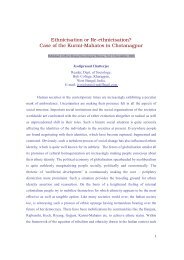Chapter 5 - WebRing
Chapter 5 - WebRing
Chapter 5 - WebRing
You also want an ePaper? Increase the reach of your titles
YUMPU automatically turns print PDFs into web optimized ePapers that Google loves.
CHAPTER 5. MAGNETIC SYSTEMS 261<br />
(b) Show that the partition function Z(T,H,N) can be expressed as<br />
Z(T,H,N) = e −NqJm2 /2kT <br />
··· <br />
e (Jqm+H) i si/kT<br />
s1=±1<br />
= e −NqJm2 /2kT <br />
s=±1<br />
sN=±1<br />
e (qJm+H)s/kT N<br />
(5.125a)<br />
(5.125b)<br />
= e −NqJm2 /2kT 2cosh(qJm+H)/kT N . (5.125c)<br />
Show that the free energy per spin f(T,H) = −(kT/N)lnZ(T,H,N) is given by<br />
f(T,H) = 1<br />
2 Jqm2 −kT ln 2cosh(qJm+H)/kT . (5.126)<br />
The expressions for the free energy in (5.107) and (5.126) contain both m and H rather than<br />
H only. In this case m represents a parameter. For arbitrary values of m these expressions do not<br />
give the equilibrium free energy, which is determined by minimizing f treated as a function of m.<br />
Problem 5.18. Minima of the free energy<br />
(a) To understand the meaning of the various solutions of (5.108), expand the free energy in<br />
(5.126) about m = 0 with H = 0 and show that the form of f(m) near the critical point (small<br />
m) is given by<br />
f(m) = a+b(1−βqJ)m 2 +cm 4 . (5.127)<br />
Determine a, b, and c.<br />
(b) If H is nonzero but small, show that there is an additional term −mH in (5.127).<br />
(c) Show that the minimum free energy for T > Tc and H = 0 is at m = 0, and that m = ±m0<br />
corresponds to a lower free energy for T < Tc.<br />
(d) Use Program IsingMeanField to plot f(m) as a function of m for T > Tc and H = 0. For<br />
what value of m does f(m) have a minimum?<br />
(e) Plot f(m) for T = 1 and H = 0. Where are the minima of f(m)? Do they have the same<br />
depth? If so, what is the meaning of this result?<br />
(f) Choose H = 0.5 and T = 1. Do the two minima have the same depth? The global minimum<br />
correspondsto the equilibrium or stable phase. If we quickly “flip” the field and let H → −0.5,<br />
the minimum at m ≈ 1 will become a local minimum. The system will remain in this local<br />
minimum for some time before it switches to the global minimum (see Section 5.10.6).<br />
We now compare the results of mean-field theory near the critical point with the exact results<br />
for the one and two-dimensional Ising models. The fact that the mean-field result (5.109) for Tc<br />
depends only on q, the number of nearest neighbors, and not the spatial dimension d is one of<br />
the inadequacies of the simple version of mean-field theory that we have discussed. The simple<br />
mean-field theory even predicts a phase transition in one dimension, which we know is incorrect.<br />
In Table 5.2 the mean-field predictions for Tc are compared to the best-known estimates of the

















